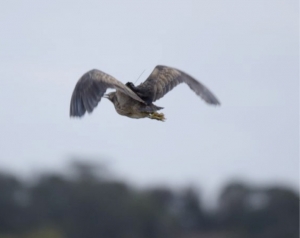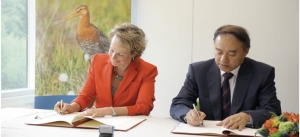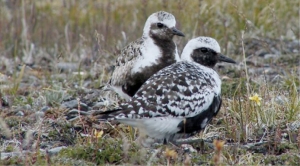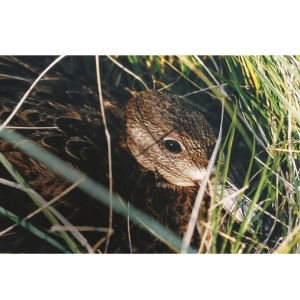Displaying items by tag: Migration
Illegal killing,
Illegal killing,
taking and trade of migratory birds
Each year an estimated 50 billion migratory birds travel thousands of kilometers.
On their migratory routes the birds have to overcome enormous obstacles. One is illegal killing. Many wild birds are illegally taken or killed due to hunting for subsistence, recreational activities and traditional practice.
This year’s World Migratory Bird Day was celebrating the natural miracle of bird migration and is calling for action to end the illegal killing and trade of birds. Illegal hunting leads not only to drastic declines of bird populations, but it also harms society in general, our very existence and our natural resources.
The Ramsar Convention on Wetlands has since its inception in 1971, paid particular attention to migratory birds. Of the current 2,240 Ramsar Sites (covering over 215 million hectares of wetlands worldwide) 1,103 (49 percent of all Sites) have been specifically designated as key sites for migratory waterbirds.
The Ramsar Convention collaborates closely with many international organisations that actively and successfully protect migratory birds across continents.
In Asia, the Ramsar Convention is a partner to the East AsianAustralasian Flyway Partnership, one of the world’s great flyways encompassing 22 countries, extending from Alaska and Arctic Russia down to East Asia and New Zealand. This migration route comprises a network of 124 wetlands, 78 of which are Ramsar Sites. These include Poyang Lake Ramsar Site in China which supports nearly the entire wintering population of Siberian crane. Poyang Lake is also critical for swan goose and other wildfowl and crane species. Mai Po Ramsar Site in Hong Kong is another vital wetland for wintering black-faced spoonbills.
Illegal hunting has recently become a high profile issue within the East Asian-Australasian Flyway especially along the coast of East Asia where a lot of illegal mist nets are being spread. To reduce this trend the Flyway Partnership carries out awareness-raising campaigns and works with local communities. In Southern Asia, local patrolling by forestry offices has brought positive results; there is a big reduction of illegal mist netting.
Spike Millington, East Asian-Australasian Flyway Partnership Chief Executive speaks about threats birds face today and encourages us to take part in bird conservation.
In Europe the Ramsar Convention collaborates with the charitable foundation Euronatur based in Germany and its Adriatic Flyway project. The Adriatic Flyway runs across the Balkan Peninsula down to the African continent. Twice a year millions of birds migrate between their wintering and their breeding grounds on this route.
The most important resting areas and wetlands (Ramsar Sites) along the Adriatic Flyway include: the transboundary Neretva Delta Ramsar Site in Croatia and Hutovo Blato Ramsar Site in Bosnia and Herzegovina; Skadarsko Jezero Ramsar Site in Montenegro and the neighbouring Lake Shkodra and River Buna in Albania; the karst plain Livansko Polje Ramsar Site in Bosnia and Herzegovina and Slano Kopovo Ramsar Site in Serbia.
Particularly during migration periods bird populations are dramatically depleted by bird crime in the western Balkans. Illegal bird hunters make the Eastern Adriatic coast a death trap for migratory birds. 55 percent of migratory wader populations along the Adriatic Flyway are in decline. Law enforcement and control is missing; however in some areas nature conservation NGOs, local communities and administrations are successfully managing important bird areas.
Another European project related to migratory birds is taking place in Greece. Responding to the need to safeguard the rarest waterbird in Europe, in September 2011, the Hellenic Ornithological Society (BirdLife Greece), took on the coordination of an ambitious multistakeholder flyway conservation project. Conservation actions span the entire range of the lesser white-fronted goose in Europe, from its breeding grounds in Scandinavia to its wintering sites in Greece. Hunting and illegal killing are recognised as major threats and patrolling units in Greece were formed to ensure that Kerkini Lake and Evros Delta, both designated Ramsar Sites, remain safe for these geese. In Africa the Ramsar Convention collaborates with African-Eurasian Migratory Waterbird Agreement (AEWA). AEWA brings together countries and the wider international conservation community in an effort to establish coordinated conservation and management of migratory water birds throughout their entire migratory range.
The most important resting areas and wetlands (Ramsar Sites), which are critical for some AEWA species in Africa are the Chad portion of the Lake Chad; Parc national du Banc d’Arguin in Mauritania, where over two million birds winter each year; Parc National du Diawling in Mauritania; Delta du Saloum in Senegal; one of the largest tropical wetlands in the world - the Sudd in Southern Sudan; and finally the Okavango Delta in Botswana.
AEWA and CMS (Convention on Migratory Species of Wild Animals), have undertaken some key actions to end illegal killing of birds in Africa. One of them is a development of a multi-stakeholder Plan of Action to address bird trapping along the Mediterranean coasts of Egypt and Libya. An International Task Force was established in November 2013 in Bonn, Germany, to implement the Plan of Action and to ensure that in future, bird trapping activities in Egypt and Libya will be legal and sustainable.
By joining forces and starting dialogues between all social groups and decision makers involved we can make migratory bird flyways safer places and preserve a healthy and rich environment for humans as well.
Louisiana Wetlands:
Louisiana Wetlands:
Recognising a National Treasure
May 26, 2016 | Posted by Emily McCalla in coastal restoration,
May is American Wetlands Month, and Louisiana’s coastal wetlands are some of the most productive ecosystems in North America. Not only do they provide habitat for numerous fish, wildlife and birds, but they also help improve water quality, provide recreational opportunities and protection for people and infrastructure from damaging storm surges.
Wildlife habitat and nurseries
Wetlands serve as a nursery environment for juvenile fish. The countless ponds, bays and bayous found in the Mississippi River Delta provide essential habitat for most commercial and game fish found in the Gulf of Mexico. Menhaden, shrimp, oysters and blue crab area all important commercial species that depend on healthy coastal wetlands to thrive. Additionally, fur-bearers like muskrat, beaver and mink, as well as reptiles including alligators call coastal wetlands and estuaries home.
Storm surge protection
Wetlands have an incredible value for people, too. One acre of wetlands has the capacity to hold up to 1 million gallons of water during a flood! On average, damaging storm surges are reduced by one foot for every 2.7 miles of wetlands, reducing wave energy and protecting levees and other critical infrastructure from these destructive forces of nature. The value of community protection for a one-mile strip of wetlands is valued at $5.7 million. Water filtration Wetlands also help improve water quality by filtering and retaining residential, agricultural and urban wastes. Reconnection of the Mississippi River to surrounding wetlands would help filter out nutrients that are contribute to a harmful low oxygen area in the Gulf of Mexico dubbed the “dead zone.” The shallow waters of coastal wetlands are good habitat for submerged aquatic vegetation, which can utilise the extra nutrients and potentially reduce the Gulf of Mexico dead zone as well as increasing water clarity.
Restoring Louisiana’s coastal wetlands
Louisiana holds 40 percent of the coastal wetlands in the continental US and is currently experiencing around 80 percent of all coastal wetland loss in the US. Work is underway to restore and rebuild wetlands in the Mississippi River Delta through projects in the state’s Coastal Master Plan, including sediment diversions and marsh creation. The reintroduction of Mississippi River water and sediment to its delta plain allows new wetlands to build and flourish, providing habitat for wildlife, clean water, places to recreate, and protection for storm surge.
Richie Blink, National Wildlife Federation
Robbie at Tootgarook?!
Neil flies 450 km to Moodie Swamp;
Robbie at Tootgarook?!
The following piece was posted in late May this year 2016. Bittern watchers take note…
As if Neil’s spectacular 450 km dispersal wasn’t enough, photos taken in May have watchers wondering which of their other bitterns are down near Melbourne. But first Neil. He left his rice crop at Murrami and flew to Moodie Swamp, a top notch canegrass wetland between Benalla and Yarrawonga in northern Victoria. It was a u-turn of sorts, taking him via the Wakool River between Moulamein and Swan Hill.
Initially they thought he might be heading toward the same area Robbie dispersed at last season, but he made two of his own new connections. They know that the wetlands of northern Victoria and canegrass wetlands are part of the network that sustains the world’s largest known Australasian bittern breeding population. “To think Robbie was in our arms at Murrami just 20 days earlier was amazing.”
Moodie Swamp had recently received environmental water and is well known for its significance to wildlife, not least as a regular Australasian bittern site. While studying Brolgas 16 years ago, I had the pleasure of finding bitterns there and meeting May Moodie. She was a great custodian for this great swamp.
Now, back to Melbourne. One of the bitterns was photographed at the Tootgarook Swamp in May. That’s down around Port Phillip Bay. We know it’s not Neil. We’re trying to work out who it is. Could it be ROBBIE?!
Massive thanks to Cam Brown and Jess Durrant who found this bittern. They both contributed to the crowd funding and joked that one of the tracked bitterns might rock up there. It’s a fitting reward for them and the swamp they love so much. Irrespective of the identity, the link between this most significant wetland near Melbourne and the rice crops of the New South Wales Riverina has been cemented.
World heritage site northern Australia
At Mungalla Stud, a property of 880 hectares there are approximately 230 hectares of seasonally inundated wetlands which are adjacent to the World Heritage Great Barrier Reef and also the IUCN listed Halifax Bay Wetlands National Park.
These wetland have been degraded by invasive plants as a result of installing an earth wall to halt the flow of saline tidal water into the wetlands and by spread in to the wetland of these “weeds of national significance”. This has resulted in major changes to the nutrient regimes, ecosystem stability and function of the wetlands.
While biodiversity and amenity values have been compromised there is excellent capacity for restoration. The Nywaigi Traditional owners have determined to return the wetlands to a more natural state and through a series of projects funded through the Australian Government they have begun the process of rehabilitation.
Since the start of restoration the Mungalla Aboriginal Corporation for Business has concentrated on:
- Weed control on the Annabone Wetlands
- Revegetation Molongo creddk
- Removal of the earth wall
- Weed control in Palm Creek and other fringes.
Mungalla acknowledge and thank the Australian Government for funding and assistance through the Caring for Country programme. Community action Grants and the Biodiversity Fund and they acknowledge the support of the GBRMPA through the Sea Country grants.
“We have benefitted and worked really well with CSIRO who are providing Mungatta Aboriginal Corporation with advice and scientific direction on the rehabilitation and restoration of our wetlands.
This partnership has grown over the last 10 years and we appreciate the support of CSIRO and Dr Tony Grice. And especially acknowledge Mike Nicholas a friend and mentor, and we thank him greatly”.
Jacob Cassady (Director) and Chris Cassady (NRM Manager).
China steps up
During a historic visit to Wetlands International’s Head Office in the Netherlands on May 24, this year (2016), the State Forestry Administration (SFA) of the People’s Republic of China strengthened international collaboration for wetland conservation. The delegation was led by the State Forest Administration’s Vice-Minister, Mr Chen Fengxue. During the visit he signed a new Memorandum of Understanding with Wetlands International’s CEO, Jane Madgwick and met the Chair of Wetlands International, André van der Zande.
The discussions focused on how SFA and Wetlands International can collaborate in the coming years, for example on implementation of the Sustainable Development Goals in China, management and restoration of peat lands for climate mitigation and adaptation, and on the conservation and restoration of coastal ecosystems of outstanding importance for waterbirds, including through international collaboration to conserve Yellow Sea wetlands.
Through the discussions commitments for further collaborations were also reached, including a joint-workshop on river basin management and “room for the river” approaches, further programmes on peat lands, and technical exchange between the Wadden Sea and the Yellow Sea. Most importantly, the meeting was an opportunity to strengthen the friendship.
CEO, Jane Madgwick said: “The value of wetlands for people and nature are better recognised in China than in most countries. But with rapid growth and development, wetlands have come under great pressure. We are keen to share knowledge and collaborate with SFA and other ministries in China to find ways to safeguard and restore wetlands as a cornerstone of sustainable development.”
China has enormous wetland wealth and has already included almost 18 million hectares of wetlands in nature reserves. Recognising that challenges linked to urbanisation, flood management, water scarcity, desertification, climate change and human health all connect to the status of China’s rivers and wetlands, the SFA, the focal agency for wetlands, developed a National Wetlands Conservation Action Plan with 17 other ministries to guide measures for wetlands involving all sectors.
Wetlands International has collaborated with SFA since the 1990s, an office was established in Beijing in 1996 and the government of the People’s Republic of China became a member of Wetlands International in 2000. In particular the collaboration has resulted in community-based management and rehabilitation of the vast high mountain peat lands of the Ruoergai Marshes on the Qinghai Tibetan Plateau and the peat lands of the Altai Mountains in NW China.
Wetlands International plays an important role in raising awareness about wetland values for people and nature and has supported the development of Wetland Parks in cities across China. Most recently, Wetlands International China organised a major waterbird count in the Yellow Sea wetlands, to highlight the importance of the remaining wetlands for waterbird conservation.
Plovers go to Russia for love
Two small migratory shorebirds - Grey Plovers from the Adelaide International Bird Sanctuary - made it once again all the way to the remote Wrangel Island off the coast of Russia near the Arctic Circle.
On their annual migration to breed the birds fly over 13000kms from Thompson Beach, north of Adelaide, including an incredible 7000km non-stop stretch from Adelaide to China.
“Who would have thought that a bird at Thompson Beach would, just a few months later, be roosting among polar bears and musk ox?” said Natural Resources Adelaide and Mt Lofty Ranges Manager of Coast and Marine, Tony Flaherty.
Mr Flaherty said the plovers were tagged with tiny solar-powered satellite trackers, to discover what parts of the Adelaide International Bird Sanctuary and Gulf St Vincent they use. Researchers also wanted to learn where they go and stop along their epic journey to the Arctic breeding grounds.
“Little was known about the migratory route of the plover, and knowing where these birds go really helps with conservation efforts to protect shorebirds,” Mr Flaherty said.
The tagged plovers left in March to fly along the East Asian-Australasian Flyway, taking distinctive routes to the northern hemisphere.
Mr Flaherty said uncovering this Grey Plover migration route can also help with international efforts to conserve their stop-over sites in Plover pair: Distinctive and tough birds. China and nesting sites in the Arctic.
“Disturbance and impacts to coasts across the birds’ migratory route all add up. What we do on our local beaches can also help these birds prepare for these incredible journeys.”
Researchers were also surprised at how little the birds moved from Thompson Beach during the Australian Summer. Here they spent their time feeding on the rich tidal flats and roosting on the beaches and nearby salt marsh and lagoons.
During the warmer months, the Adelaide International Bird Sanctuary, located north of Adelaide, is home to approximately 27000 resident and migratory shorebirds. The area provides a safe haven for the shorebirds and a smorgasbord for feasting.
The research has been carried out by a partnership between Friends of Shorebirds SE, the Victorian Wader Study Group and the South Australian Department of Environment, Water, and Natural Resources, with funding support from the Adelaide and Mt Lofty Ranges Natural Resources Management Board Shorebird Project and the Australian Government-funded Samphire Coast Icon Project.
A duck in spring - in Canada
Each spring, Canadians herald the sights and sounds of waterfowl as they flock to their nesting grounds. But after their long trips, life for our feathered friends isn’t easy. Ducks – especially females – undergo arduous physical and biological processes before, during and after their journeys. And once here, most hens have one shot to raise a brood.
It’s early June on the Saskatchewan prairies. A slight breeze gives her wings a lift as she circles over a patch of native grassland next to a shallow pond. She decides to land in a small clearing, then walks into the grassy cover. It’s the third spot she’s scouted. She feels safe here.
In the coming days, this blue-winged teal hen will construct a nest with nearby vegetation and line it with down plucked from her breast. She’ll feed on invertebrates to build her energy for an important role: producing a brood.
It’s no easy gig. She’ll need all the energy she has to give.
When male and female waterfowl prepare for their journey from their southern wintering grounds northwards to Canada, they do so in similar ways. The process differs between the sexes once they arrive. David Howerter, PhD, director of national conservation operations at Ducks Unlimited Canada (DUC) explains how, and why ducks do what they do – before and when they get here.
A shared experience: preparing for migration
Feeling restless – Ever wonder what pushes migratory waterfowl to bid adieu to their warm winter homes?
It’s a physiological process called zugunruhe (pronounced: zoo-gun-roo). This German term refers to the restlessness birds experience as migration nears. Zugunruhe is triggered by the endocrine system (a collection of glands that release hormones into their blood stream) in response to longer daylight hours. “As it gets closer to the time for these birds to migrate they become increasingly active,” says Howerter. “They’ll spend more time flying and their movements will begin to orient in the direction they intend to migrate.”
No exceptions – Zugunruhe impacts migratory waterfowl wintering close to the equator, where daylight hours remain consistent, year-round. This may be a result of evolutionary hangover from when the species had a different distribution, or because of the changing angle of the sun.
Packing on the pounds – “Before ducks begin their journey north, they’ll go through a phase biologists refer to as hyperphagia, where they’ll spend a lot of their days consuming calories,” explains Howerter. “This is done to prepare for their long trip.” Like zugunruhe, hyperphagia’s also triggered by hormonal changes, influenced by changing daylight hours.
Growing closer – Migratory waterfowl can only procreate from spring until late summer. This is because in the “off-season” their reproductive organs shrink, making it easier to fly over long distances. As birds close in on their breeding grounds, their endocrine system releases hormones that stimulate their reproductive organs to grow larger again in anticipation of breeding.
It’s all about her: producing a clutch
Once waterfowl arrive at nesting sites, the male-female experience begins to diverge. “Once they have fertilised the eggs and the hen is incubating, the drakes will take off. Often they’ll go further north, to the boreal forest,” says Howerter.
Meanwhile, the hens prepare for one of the most difficult processes they’ll go through in their lifetime: producing a clutch of eggs.
Size matters – How waterfowl behave once they arrive at the nesting site depends on whether they’re capital or income breeders. “Capital” breeders are large-bodied ducks that can store enough energy (calories) to migrate thousands of kilometres and arrive ready to lay a clutch of eggs, and incubate them for about 30 days. One example of a capital breeder is the common eider, which averages between two and six pounds.
“Income” breeders like the far smaller blue-winged teal (weighing in at 400 grams) are unable to sustain the same kind of fuel reserves. When they arrive at the nesting grounds, they’re looking for protein- and calcium-rich foods, like invertebrates, that provide the nutrients they need to produce a clutch of eggs
Medium-size waterfowl like mallards fall somewhere between capital and income breeders. “Birds of average size usually have enough nutrients to initiate the first clutch of eggs, but they don’t have enough reserves to re-nest,” says Howerter. However, some duck species (like mallards, which are persistent re-nesters) will produce a second or third clutch if their first one is unsuccessful.
Nesting is natural – Birds, like people, experience the urge to nest before they welcome offspring into the world. Expectant bird and human parents alike can trace this feeling to the hormone prolactin. Prolactin is released into the blood stream by the pituitary gland, found at the base of the brain.
Laying a clutch of eggs – A hen’s pituitary gland will also release two hormones that stimulate egg production: follicle-stimulating hormone and luteinizing hormone. They trigger ovulation. Once a duck begins to ovulate, a drake can fertilize her egg – then things begin to take shape. “Once the ovum is fertilised the egg starts to develop.
The yolk provides nutrients to the developing embryo and albumen (egg white) is deposited around it, followed by the shell. About seven days later, the hen will lay an egg,” says Howerter.
A blue-winged teal hen will lay between six to 14 eggs, provided she has the energy required to develop them. “Producing a clutch is very energetically expensive,” says Howerter. “In humans, it can be compared to giving birth to an eight-pound baby once a day for nine to 10 days.”
Sitting still – Once a duck has laid her eggs, she will spend nearly one month incubating them. While some ducks, like common eiders, will stay on their nest nearly continuously, other birds take more frequent breaks to eat. “But even they will lose roughly 30 per cent of their body weight,” says Howerter. In some cases, hens may abandon their clutch if conditions become unfavourable (bad weather, predators, disease).
Crack! – The eggs have hatched. Finally, mom can focus on relaxing and refueling, right? “Not exactly,” says Howerter. Instead, she’ll help her ducklings find food high in protein and calcium, required for muscle and skeletal development. While ducklings are precocial (mobile after hatching), they still need help to find suitable habitat and food.
Bidding farewell – After 30 to 40 days, many hens will leave their broods to prepare for moulting (the process in which ducks lose their flight feathers). “The ducklings are on their own after that,” says Howerter, noting at this point young waterfowl are able to source their own food. At a month old, ducklings are also faster and stronger, making them far more difficult for predators like foxes, raccoons, red-tailed hawks and mink to catch and eat.
Back amidst the grasses, the blue-winged teal hen has hatched a healthy brood of ducklings and led them to the nearby wetland. In future years, these ducklings will return to the prairie landscape to produce their own offspring and repeat this fascinating but strenuous process of duck-rearing.
Continuing that cycle depends on a key ingredient, says Howerter. “Good habitat across Canada’s waterfowl breeding grounds is essential to overcoming the many challenges of successful reproduction for returning birds.”
Healthy and plentiful habitat. It’s the best welcome mat we can roll out for waterfowl every spring.
Julielee Stitt
Communications coordinator for Ducks Unlimited Canada.




